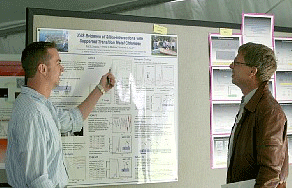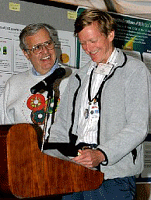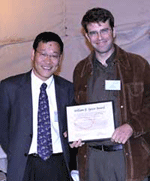
E. Deguns & G. Meitzner

Contents of this Issue:
1.
Accelerators Shut Down at SLAC Following Electrical
Accident
(contact: Keith Hodgson,
Hodgson@ssrl.slac.stanford.edu)
As many of you are aware, on Monday, October 11, a very serious electrical accident took place in the SLAC Linac gallery resulting in severe burns to the contract worker involved. The worker's condition has since improved from critical to stable.
SLAC Director Jonathan Dorfan took decisive action, calling for all accelerators on the SLAC site to be shut down and all regular work to be suspended (with only a few exceptions to maintain emergency and essential services). During the lab-wide safety stand-down the staff has been directed to focus exclusively on, and to take individual ownership of, the safety aspects of their work. The DOE has an investigation team on-site now and they are expected to complete their work and deliver a report within about 2 weeks. Only at that time will the real nature of the accident and its causes become known.
As of the posting of this newsletter, some of the activities on site such as business services and "desktop activities" are returning to a more normal schedule. Work in certain areas, including electrical and hoisting and rigging, remains extremely restricted. An external review committee will be reviewing procedures and process for work in these areas and will advise the SLAC director on resumption of work. Resuming work in these areas and knowledge and corrective actions as a result of the DOE investigation are essential steps in beginning to work toward accelerator restart. At this time, it is not possible to accurately predict when we will be able to resume SPEAR user operations, but every effort will be made to keep you all informed as the planning for restart of operations moves forward in the coming weeks. We sincerely regret the impact that this delay in resuming SPEAR operations may have on your research programs and hope to accommodate your beam time needs later in the schedule. Please understand, however, that building a safer laboratory for our workers and for you being here as users is our top priority.
If you have any suggestions regarding user safety issues and procedures, please
contact any member of the SSRL Users' Organization Executive Committee or
myself (email contact above). Contact information for the SSRLUO is available
at:
http://www-ssrl.slac.stanford.edu/users/ssrluo/ssrluoec-fy05.html
2. Science Highlight —
XAS Provides Scientific Basis for Technetium Nuclear Waste Remediation in the
Hanford Tanks
(contact: Wayne W. Lukens,
wwlukens@lbl.gov)
The Hanford nuclear waste site in southeastern Washington State is one of the most contaminated sites in the DOE complex. It stores millions of gallons of radioactive waste from the nation's nuclear weapons programs. High-level radioactive waste is leaking from about a third of Hanford's underground tanks.
The waste includes the element technetium in the radioactive form of 99Tc, which poses a grave threat because of its long half-life (213,000 years) and its potential to contaminate ground water and migrate towards the Columbia River. Radioactive chemicals infiltrating the environment are a cancer hazard to humans.
The proposed solution for remediating Tc is to chemically separate it from the tank wastes and store it in solid glass, a process called vitrification. But separating 99Tc into the proper phase before vitrification is proving difficult in some of the tanks because it forms unknown compounds in some storage conditions. To determine the identity of these unknown 99Tc compounds in the waste, Wayne Lukens of Lawrence Berkeley National Laboratory and his collaborators performed experiments at SSRL using a technique called XAS, X-ray Absorption Spectroscopy, which uses x-rays to boost electrons to higher-energy states, and provides electronic and geometric structural information. Comparison of the experimental results to spectra from known compounds indicates that the unknown species is a Tc(I)-carbonyl species. These results are extremely valuable because they indicate that technetium separations technologies must be formulated to be effective for Tc(I)-carbonyl species.
To learn more about this research, see:
http://www-ssrl.slac.stanford.edu/research/highlights_archive/technetium.html
or
http://www-ssrl.slac.stanford.edu/research/highlights_archive/technetium.pdf
3. Science Highlight —
Anthrax Toxin Hijacks Its Way into Human Cells
(contact: Robert C. Liddington,
rlidding@burnham-inst.org)
X-ray images have revealed how anthrax hijacks important cell machinery to enter and destroy human cells. Researchers from The Burnham Institute and the National Institute of Allergy and Infectious Diseases discovered the structure of an anthrax toxin bound with a cell receptor using data taken at SSRL. The clearer picture of how anthrax works brings researchers closer to the development of a therapy against anthrax infection as well as a new cancer therapeutic.
Bacillus anthracis makes three toxins that disrupt our immune systems. One, called protective antigen (PA), can bind to two types of receptors on the surface of human cells. PA hijacks the receptor called CMG2, forcing it to act as a molecular switch to send PA and the other anthrax toxins into the cell. Once inside, the toxin stops the cells from mounting an immune response to the bacteria, and ultimately kills the cell. The new information on how PA recognizes and tricks cell receptors is potent information for designing anti-anthrax drugs that derail the PA-CMG2 interaction. The other cell receptor that PA recognizes is found primarily on the surface of cells lining the blood vessels that supply nutrients to tumors. Killing these cells using an engineered toxin presents a possible new cancer treatment.
To learn more about this recent article in Nature see:
http://www-ssrl.slac.stanford.edu/research/highlights_archive/anthrax3.html
or
http://www-ssrl.slac.stanford.edu/research/highlights_archive/anthrax3.pdf
4.
Record Attendance at 31st Annual Users' Meeting and Workshops
(contact: Cathy Knotts,
knotts@slac.stanford.edu)
Congratulations and many thanks to Mike Toney (SSRL), Glenn Waychunas (LBNL) and the SSRL administration staff for organizing an outstanding Users' Meeting! Over 350 people participated in the 31st Annual Users' Meeting, workshops, and social events on October 20-26, 2004. In the opening session, SLAC Director Jonathan Dorfan updated users on the electrical accident that has shut down the accelerators at SLAC. Keith Hodgson gave an update on SSRL activities, and Pat

E. Deguns & G. Meitzner |
5.
Congratulations to Hal Tompkins, Recipient of the 2004 Farrel Lytle Award
 | |
| P. Pianetta & H. Tompkins | |
6.
Peter Armitage Receives First W.E. Spicer Young Investigator Award
 Z.-X. Shen & P. Armitage |
7.
SSRL/Stanford Faculty Position in "Ultrafast X-ray Studies of Matter"
(contact: Gordon E. Brown, Jr.,
gordon@pangea.stanford.edu)
The Stanford Synchrotron Radiation Laboratory invites applications for a faculty position (Assistant, Associate or Full Professor) in the general area of x-ray science with emphasis on studies of ultrafast processes in matter. Applicants should hold an earned doctorate in a core science and engineering discipline and should have outstanding potential for establishing an independent research program utilizing and developing ultrafast x-ray capabilities for investigations of matter. Senior applicants are expected to have made outstanding scholarly contributions to their field and to have a professional standing among the very best in that field.
We are interested in an individual with research experience in synchrotron radiation research and expect that the candidate's research program will be based in part on utilization of SSRL's existing x-ray sources SPEAR3 and the Sub-Picosecond Pulse Source (SPPS) with emphasis on future use of the Linac Coherent Light Source (LCLS), the first x-ray free electron laser worldwide. Experience in technique development is desirable, but the emphasis should be on the application of techniques to science and engineering problems.
Applicants should submit a summary of their educational and professional background, a current list of published work, and the names of at least three referees who may be consulted by the search committee. A brief summary of how the candidate's experience matches the position described above should also be submitted with the application. Applicants are also encouraged to submit a brief description of their plans for future research and how those plans might be realized in the SSRL setting. Applications should be submitted by December 31, 2004 to:
Prof. Gordon E. Brown, Jr.
Chair SSRL Faculty
Stanford Synchrotron Radiation Laboratory, SLAC
2575 Sand Hill Road, MS 69
Menlo Park, CA 94025
USA
 | Stanford University is an equal opportunity employer and welcomes nominations of women and minority group members and applications from them. |
8.
CCLRC Directors Visit SLAC
(contact: Keith Hodgson,
Hodgson@ssrl.slac.stanford.edu)
Professors John Wood, Chief Executive, and Henry Hutchinson, Director of the Central Laser Facility at the Council for the Central Laboratory of the Research Councils (CCLRC), visited SLAC earlier this month to discuss areas of possible collaboration in accelerator physics, synchrotron and x-ray FEL science, detector development and particle astrophysics. During this visit, a Memorandum of Understanding was signed between SLAC and CCLRC regarding participation in these areas.
The CCLRC was established by Royal Charter under the Science and Technology Act of 1965. The CCLRC has a key role in providing the national facilities and technical expertise for very large instruments such as neutron and synchrotron x-ray sources and lasers. It also coordinates UK research programs in space and particle physics. The CCLRC consults with the UK and international science communities in order to meet the changing requirements of the dynamic world of research.
9.
Former SSRL Staff Scientist Stan Ruby Dies at 80
Stanley Ruby, iconoclastic nuclear physicist, 80, passed away peacefully on October 18 in Los Gatos, Calif. His boundless intellectual curiosity and passion for life was an inspiration (and sometimes an exasperation) to his family, friends, and colleagues. Beyond his consuming interest in physical science, his many pursuits included international travel, outdoor recreation, marine life, and observing the human parade. Born in New York in 1924, Stan served in the U.S. Army Signal Corps during World War II in New Guinea and the Philippines. He received his undergraduate and graduate degrees at Columbia University. His career in experimental physics centered on x-ray scattering and the Mossbauer Effect and included stays at Brookhaven National Laboratory, Westinghouse Research, the Weizmann Institute, Argonne National Laboratory, and the Stanford Synchrotron Radiation Laboratory. He was a visiting professor in Israel, Taiwan, and Munich. After his retirement, he continued active investigations into theories of gravitation. His lifelong concern with the impacts of science on society was expressed in his leading role in the campaign against anti-ballistic missiles during the 1970s.
10.
Information Requested for Reports to SSRL Funding Agencies
SSRL submits several reports each year to the Department of Energy and the National Institutes of Health which require current information on publications listings, invited lectures and major awards, patents and science highlights. In the near term we will be sending out a request for information for inclusion in our Annual NIH, NCRR/Biomedical Technology Program (BTP) Progress Report and in our response to the DOE's request for information for an upcoming peer review of our facility in January 2005. This information is extremely important in presenting our scientific achievements and productivity, and thus funding case to these agencies and we would very much appreciate your help and support in providing this information upon request.
11. User Research Administration Announcements
(contacts: Cathy Knotts,
knotts@slac.stanford.edu; Lisa Dunn, lisa@slac.stanford.edu)
There is still a little time remaining to meet the November 1, 2004 deadline
for new X-ray and VUV proposals. Macromolecular Crystallography proposals are
due December 1, 2004. see:
http://www-ssrl.slac.stanford.edu/users/user_admin/guide.html
__________________________________________________________________________
SSRL Headlines is published electronically monthly to inform SSRL users, sponsors and other interested people about happenings at SSRL. SSRL is a national synchrotron user facility operated by Stanford University for the U.S. Department of Energy Office of Basic Energy Sciences. Additional support for the structural biology program is provided by the DOE Office of Biological and Environmental Research, the NIH National Center for Research Resources and the NIH Institute for General Medical Sciences. Additional information about SSRL and its operation and schedules is available from the SSRL WWW site.
__________________________________________________________________________
To leave the SSRL-HEADLINES distribution, send email as shown below:
To: LISTSERV@SSRL.SLAC.STANFORD.EDU Subject: (blank, or anything you like)
The message body should read
SIGNOFF SSRL-HEADLINES
That's all it takes. (If we have an old email address for you that is forwarded to your current address, the system may not recognize who should be unsubscribed. In that case please write to ssrl-headlines-request@ssrl.slac.stanford.edu and we'll try to figure out who you are so that you can be unsubscribed.)
If a colleague would like to subscribe to the list, he or she should send To: LISTSERV@SSRL.SLAC.STANFORD.EDU and use the message body
SUBSCRIBE SSRL-HEADLINES
|
SSRL Welcome
Page | Research
Highlights | Beam Lines | Accel
Physics
User Admin | News & Events | Safety Office |